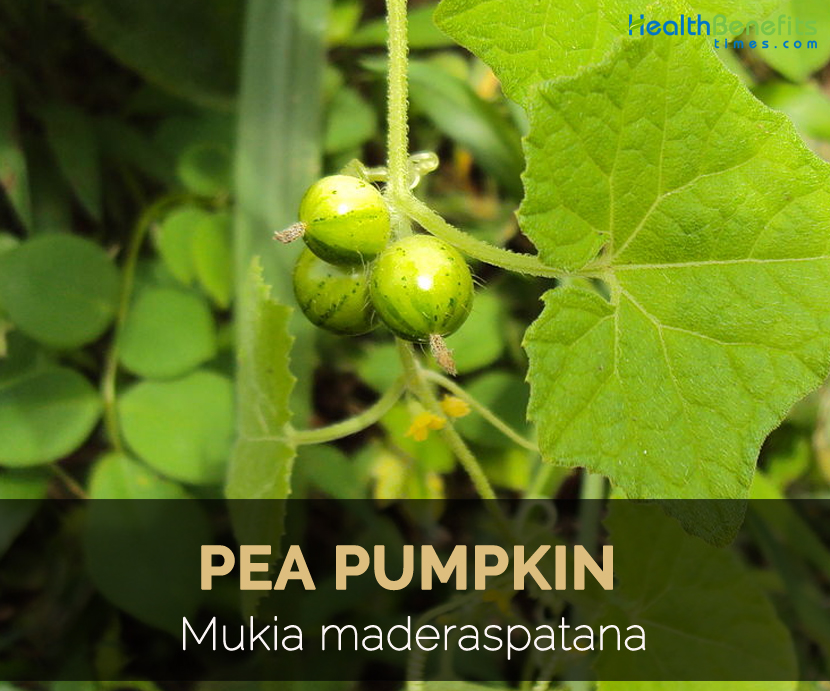Animal experiments have shown various traditional or folkloric medicinal claims that include hypolipidemic, hypotensive, hypoglycaemic, hepatoprotective, immunomodulatory, antiulcer, antimicrobial, local anaesthetic and anxiolytic characteristics of plant extracts.
Plant
Pea pumpkin is a prostate or climing scabrid herbs. Stems are branched, robust and sulcate. Leaves are ovate-deltoid measuring 4-8 x 3-7 cm, angular or shallowly 3-5 lobed, margin denticulate, base cordate, apex acuminate, scabrid on both sides. Petioles are 6 cm. Flowers (male) are in axillary and sessile clusters. Calyx tube is villous about 2 mm and lobes are erect and subulate. Petals are 3 mm long which is obtuse, ovate to oblong and yellow. Female flowers are solitary and in clusters. Berries are red, globose about 1.2 cm across. Seeds are rugose and lenticular.
Traditional uses
- In Nigeria, the decoction of young shoots and leaves are used as aperient for children.
- In India, bitter leaves and tender shoots are used for vertigo and biliousness.
- Leaf sap is used in Tanganyika as a dressing for wounds, amoebiasis and leaves are used as a poultice for burns.
- In Nigeria, seed are chewed or used in decoction to induce perspiration.
- In Senegal, fruits are used as a vermifuge.
- In Nigeria, roots are used to provide relief from toothache and facial neuralgia.
- Mix small quantity of pointed gourd with pinch of turmeric with 4/5 garlic added to water in form of concoction. It is helpful for sore throat due to cold.
- Use the leaves for maintaining normal glycemic index.
- The daily intake of Nugu dasari provides relief from cough.
- Add grinded fenugreek seeds with Patol to promote strength and stamina in both genders.
- Add dry grapes to musumusukai for controlling vomiting.
- To treat bile related diseases, grinded amla fruit with the plant for healing bile problems.
- For asthma, soak musumusukai juice with long pepper for few hours. Dry it in the sun and powder it. Take two grams of this powder with honey on betal leaf.
- In Siddha, leaf and roots are used for treating dyspnea, fever, hepatic disorders, abdominal disorders, vomiting and cough.
- Leaf decoction is used for treating hypertension and nasobronchial diseases.
- The herb is useful in treating allergic bronchitis, bronchial asthma, bronchiectasis, chronic bronchitis, cold, productive cough, upper or lower respiratory tract infections and difficulty in breathing.
- It controls endless cough, wheezing, cold, dry cough, allergic, tuberculosis and asthma.
References:
http://www.plantnames.unimelb.edu.au/Sorting/Mukia.html
https://davesgarden.com/guides/pf/go/228170/
https://plants.jstor.org/stable/10.5555/al.ap.upwta.1_1212
https://www.zimbabweflora.co.zw/speciesdata/species.php?species_id=156990
http://wildedibles.teriin.org/index.php?album=Wild-edibles/Fruits/Mukia-maderaspatana
http://www.theplantlist.org/tpl/record/kew-2371639
https://spinachwonders.blogspot.com/p/mukia-maderaspatanamusumusukai.html
Comments
| Pea pumpkin Quick Facts | |
|---|---|
| Name: | Pea pumpkin |
| Scientific Name: | Mukia maderaspatana |
| Colors | Green, turning to orange and red |
| Shapes | Globose, 6-11 mm in diameter |
| Name | Pea pumpkin |
|---|---|
| Scientific Name | Mukia maderaspatana |
| Common/English Name | Headache Vine, Rough Bryony, Madras Pea Pumpkin, Hong Gua, Aganaki, Agumaki, Bilari, Melon-gubat |
| Name in Other Languages | Bengali: Bilari; Chinese: Hong gua, Mao er gua (帽儿瓜), Mao hua ma jiao er (毛花马姣儿); English: Rough bryony Madras pea pumpkin; Gujarati: Tindori; Hindi: Agumaki, Aganaki, Bilari (बिलाड़ी), Musmusa (मुसमुसा), Paripushkara (परिपुष्करा); Japanese: Sango ju suzume uri; Kannada: Chitrati; Konkani: Chirati (चिरटी); Malayalam: Chitrati, Mukkalpeeram, Mukkpeeram, Mukkalpiram; Marathi: Bilavi, Chirati (चिरटी); Nepalese: Matyangre kankri (मट्याङग्र काँक्री); Punjabi: Gwala kakri; Sanskrit: Kritarandra, Musimusikkay, Krtarandhrah, Paripushkara (परिपुष्करा), Trikosaki; Tamil: Muchumuchukkai (முசுமுசுக்கை), Musumusukkai , Musumuskkai, Musumuskkai, Nagilangiai; Telugu: Musumusukaya, Nugudosa (నూగుదోస), Potti budamu; Thai: Taeng nok, Taeng phi pluk, Taeng nu; Urdu: Musmusa (مسمسا) |
| Plant Growth Habit | Annual scandant or trailing herb |
| Plant Size | 4 m long |
| Leaves | Broadly ovate to triangular or palmately 3(-5) lobed, 3-9 cm long |
| Flower | Small, yellow, 1 cm across |
| Fruit shape & size | Globose, 6-11 mm in diameter |
| Fruit color | Green, turning to orange and red, as they mature |
| Fruit peel | Smooth, hairless |


